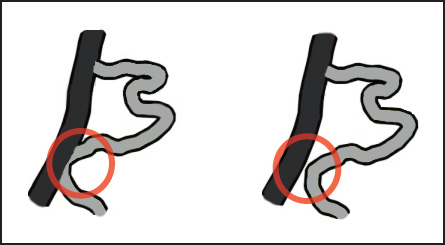|
|
Displacement and Orientation
Displacement
When map elements are too close together after scaling, they must be displaced in order to avoid their visual merging. Displacement
also occurs when small differences in position are important to the map user. A typical example of such displacement is shown
in the last example of the previous learning object (exaggeration).
Orientation
When two map elements have an unusual angle (15°, 75°, etc), one of them
has to be rotated in order to avoid visual conflict. Two solutions are usually
possible: either the two elements are placed alongside, or at an angle of 45°.
Displacement and Minimum Distance between Elements
When a map element is exaggerated, the minimum distance between this element and others is often no longer respected. This
element has to be displaced. Therefore, a
road can be displaced to show there is no intersection with an other one.
 Road displacement
Road displacement
In the following example, the minimum distance (0.2 mm) between the house (red square) and the road is not respected. This
separation should be at least 0.2mm or the house should be displaced up to the road. Show graphically those two solutions
by clicking the solution buttons.
Further optional graphical information about displacement can be found in the following: Displacement.pdf (77Ko).
Orientation and Angles
In this example, the angle legibility (0 or 45°) between the house (red square) and the road is not respected. Show graphically
the two solutions to correct it by clicking the solution buttons.
